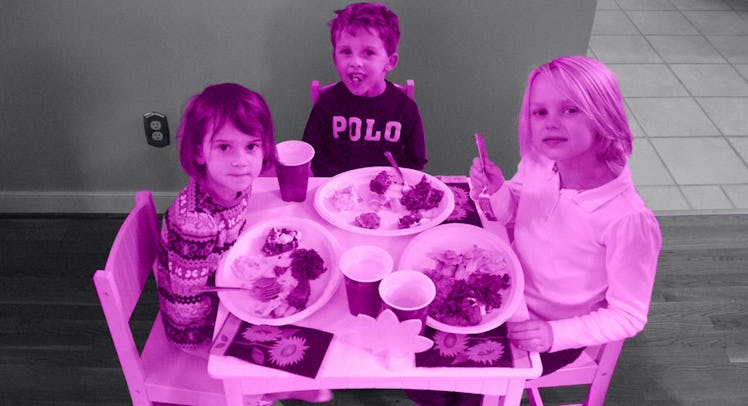The Case Against the Kids’ Table at Thanksgiving Dinner
If experts suggest that families dining together is a cure for social ills, why would we stop on the day when family dinner is required?

The kids’ table at Thanksgiving dinner is a de facto right of passage. The childrens’ plates are cheap and often straight-up disposable. The napkins are paper and juice boxes replace crystal goblets. The setup and dissociation from adults make the Turkey Day kids table a place of culinary chaos, where children tell fart jokes and play with their food with impunity. Those tiny holiday tables are often filled with laughter, but they are also gross, messy, loud and largely demeaning as a kid gets older. Sure, that makes the graduation to the adult table feel that much more victorious, but should there even have to be a graduation in the first place?
Harvard University’s Family Dinner Project has found that eating meals as a family reduces a child’s risk of drug use, early pregnancy, depression, and obesity. A family dinner is a powerful tool; a solution to many of society’s ills. So why on Thanksgiving, when eating as a family is practically mandatory, do we relegate our children to the rickety card-table outskirts? What are we really saying when we place our kids in the Thanksgiving ghetto?
The kid’s table essentially tells children they’re unhinged monsters who can’t be trusted eating with adults. We’re saying that their presence would ruin the genteel meal. So it’s not particularly shocking when they misbehave with the mashers. And it isn’t particularly surprising they’re hesitant to eat with us during the week. How could they not reach the conclusion, “I really don’t belong here”?
Worse still is when the family screw-up is relegated to kids’ table, too. After all, if weird uncle Jack is bummed to be hanging out with the kids, then it’s not that hard to internalize the idea that eating with the kids is considered punishment.
Sure, I understand that there are logistical barriers to having everyone at the table. Far be it from me to shame someone for a lack of square footage. But the nice thing about kids is that they don’t really take up that much space. They’re small creatures on average. And it’s truly worth the effort to add an extra table-leaf or squeeze them between aunts and uncles, rather than keeping them in a faraway room. If it’s possible to have them at the table, there’s really no excuse for keeping them away.
Which is not to say that people don’t think they have good excuses: kids might cry, spill, make a mess, break something or be otherwise disruptive. Yep. They might. Because they are children. But children are also incredibly funny and thoughtful when adults take a breath, relax, and let them be themselves.
For instance, two years ago at our family Thanksgiving dinner, our children were at the table and my 4-year-old son asked to say grace. The clan decided to take a chance. What followed was the purest one-and-a-half minute prayer any of us have ever heard (much less uttered). In his sweetest little conversational tone, he asked for blessings for the food and the “aminals” and his cousins. He asked God for fun and desserts and thanked Him for the dead relatives in heaven. The entire table grinned at the Amen. Perhaps we never would have known the joy and gratitude of a child’s heart if we’d stowed him away at a rowdy kids’ table.
And let’s be serious. Can kids lead to chaos at the table? Absolutely. But so can arguing about the results of the midterm elections. It’s contingent on the adults to relax and let shenanigans slide. After all, we are tasked to be thankful for more than just food at the Thanksgiving feast. We are also tasked with being thankful for those that surround us, regardless of how many fingers they dip in the gravy.